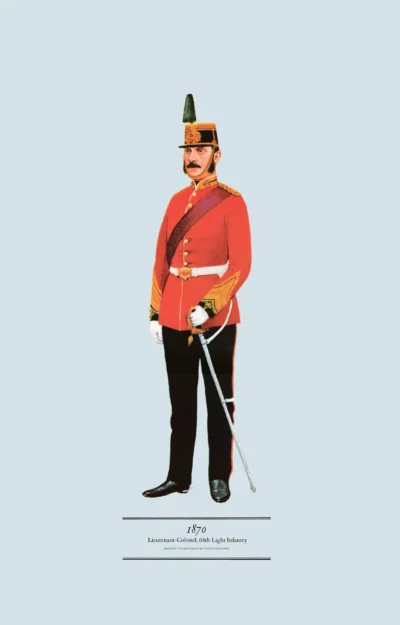Lt-Col 68th (Durham) Lt Infantry, 1870
£12.50
Raised in 1756 as 23rd Foot; from 1881 the Durham Light Infantry; in 1968 The Light Infantry and from 2007 The Rifles – RIFLES (scroll down for a more detailed Description)
Published 1970 by © Hugh Evelyn Limited; drawn by Colonel Philip Henry Smitherman (1910-1982), Royal Corps of Signals
Size: c. 24.5 x 37.5 cm [9 ½ ″ x 14 ½ ″] (may vary slightly from printers’ cut 50 years ago)
Printed on on medium cardstock weighing 144 g/sm2 faced in light greyish blue (RGB c. d4e1e8)
Print is STANDARD size – shipping is the same for 1 to 10 prints (based on largest print size in your order) – see Shipping & Returns.
In stock
Description

The 68th was raised in 1756 as 2nd Battalion, 23rd Foot but became a separate regiment in 1758. It served in the West Indies in 1800 and had to march on the West India Regiment which had mutinied. The West Indians were so impressed with precision of the advance of the 68th, they presented arms before opening fire. In 1881 the 68th, (designated ‘˜Durham’) was joined by the 106th Bombay Light Infantry to form the Durham Light Infantry. In 1968, the regiment was amalgamated with the Somerset and Cornwall Light Infantry, the King’s Own Yorkshire Light Infantry and the King’s Shropshire Light Infantry to form The Light Infantry, which again amalgamated in 2007 with the Devonshire and Dorset, the Royal Gloucestershire, Berkshire and Wiltshire, and the Royal Green Jackets to form The Rifles, which continues the lineage of the regiment.
This plate shows the further evolution of the red tunic. The skirt is shorter, and the cut of the coat takes on the appearance which it retains today. The slashed cuff was replaced by the pointed ornamental cuff shown here. The pointed cuff shown here was a mere piece of decorative millinery. The shako worn by this officer is the final form of that head-dress introduced in 1869 with a new plate in front. The green plume worn here was peculiar to light infantry regiments, the rest of the line wearing white-over-red tufts.
Additional information
| Weight | 0.0131 kg |
|---|---|
| Dimensions | 23 × 37 cm |





